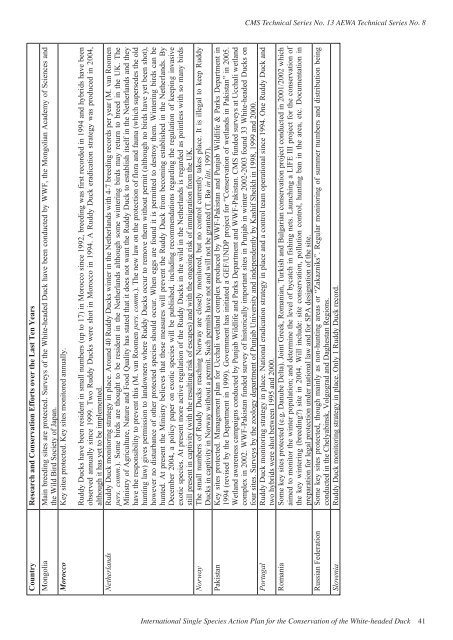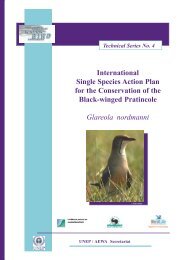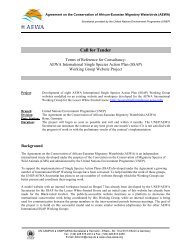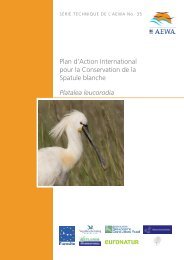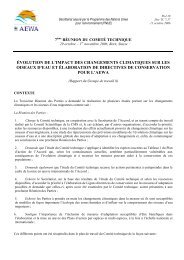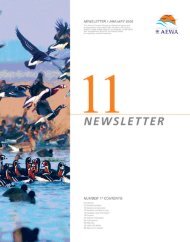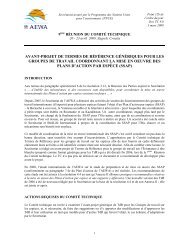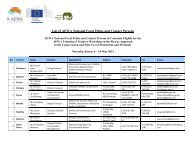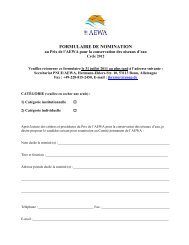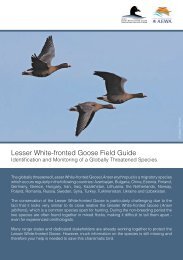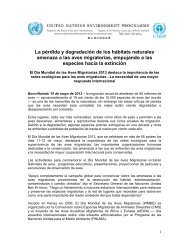International Single Species Action Plan for the Conservation - AEWA
International Single Species Action Plan for the Conservation - AEWA
International Single Species Action Plan for the Conservation - AEWA
You also want an ePaper? Increase the reach of your titles
YUMPU automatically turns print PDFs into web optimized ePapers that Google loves.
Country Research and <strong>Conservation</strong> Ef<strong>for</strong>ts over <strong>the</strong> Last Ten Years<br />
Mongolia Main breeding sites are protected. Surveys of <strong>the</strong> White-headed Duck have been conducted by WWF, <strong>the</strong> Mongolian Academy of Sciences and<br />
<strong>the</strong> Wild Bird Society of Japan.<br />
Morocco Key sites protected. Key sites monitored annually.<br />
CMS Technical Series No. 13 <strong>AEWA</strong> Technical Series No. 8<br />
Ruddy Ducks have been resident in small numbers (up to 17) in Morocco since 1992, breeding was first recorded in 1994 and hybrids have been<br />
observed annually since 1999. Two Ruddy Ducks were shot in Morocco in 1994. A Ruddy Duck eradication strategy was produced in 2004,<br />
although it has yet to be implemented.<br />
Ne<strong>the</strong>rlands Ruddy Duck monitoring strategy in place. Around 40 Ruddy Ducks winter in <strong>the</strong> Ne<strong>the</strong>rlands with 4-7 breeding records per year (M. van Roomen<br />
pers. comm.). Some birds are thought to be resident in <strong>the</strong> Ne<strong>the</strong>rlands although some wintering birds may return to breed in <strong>the</strong> UK. The<br />
Ministry of Agriculture, Nature and Food Quality has stated that it does not want <strong>the</strong> Ruddy Duck to establish itself in <strong>the</strong> Ne<strong>the</strong>rlands and <strong>the</strong>y<br />
have <strong>the</strong> responsibility to prevent this (M. van Roomen pers. comm.). The new law on <strong>the</strong> protection of flora and fauna (which supersedes <strong>the</strong> old<br />
hunting law) gives permission to landowners where Ruddy Ducks occur to remove <strong>the</strong>m without permit (although no birds have yet been shot),<br />
however no disturbance of o<strong>the</strong>r protected species should occur. When eggs are found it is permitted to destroy <strong>the</strong>m. Wintering birds can be<br />
hunted. At present <strong>the</strong> Ministry believes that <strong>the</strong>se measures will prevent <strong>the</strong> Ruddy Duck from becoming established in <strong>the</strong> Ne<strong>the</strong>rlands. By<br />
December 2004, a policy paper on exotic species will be published, including recommendations regarding <strong>the</strong> regulation of keeping invasive<br />
exotic species. At present more active regulation of <strong>the</strong> Ruddy Ducks in <strong>the</strong> wild in <strong>the</strong> Ne<strong>the</strong>rlands is regarded as pointless with so many birds<br />
still present in captivity (with <strong>the</strong> resulting risk of escapes) and with <strong>the</strong> ongoing risk of immigration from <strong>the</strong> UK.<br />
Norway The small numbers of Ruddy Ducks reaching Norway are closely monitored, but no control currently takes place. It is illegal to keep Ruddy<br />
Ducks in captivity in Norway without a permit. Such permits have not and will not be granted (T. Bø in litt. 1997).<br />
Pakistan Key sites protected. Management plan <strong>for</strong> Ucchali wetland complex produced by WWF-Pakistan and Punjab Wildlife & Parks Department in<br />
1994 (revised by <strong>the</strong> Department in 1999). Government has initiated a GEF/UNDP project <strong>for</strong> “<strong>Conservation</strong> of wetlands in Pakistan” in 2005.<br />
Wetland awareness campaigns conducted by Punjab Wildlife and Parks Department and WWF-Pakistan. CMS funded surveys at Ucchali wetland<br />
complex in 2002. WWF-Pakistan funded survey of historically important sites in Punjab in winter 2002-2003 found 33 White-headed Ducks on<br />
four sites. Surveys by <strong>the</strong> zoology department of Punjab University and independently by Kashif Sheikh in 1998, 1999 and 2000.<br />
Portugal Ruddy Duck monitoring strategy in place. National eradication strategy in place and a control team operational since 1994. One Ruddy Duck and<br />
two hybrids were shot between 1995 and 2000.<br />
Romania Some key sites protected (e.g. Danube Delta). Joint Greek, Romanian, Turkish and Bulgarian conservation project conducted in 2001/2002 which<br />
aimed to monitor <strong>the</strong> winter population; and determine <strong>the</strong> level of bycatch in fishing nets. Launching a LIFE III project <strong>for</strong> <strong>the</strong> conservation of<br />
<strong>the</strong> key wintering (breeding?) site in 2004. Will include: site conservation, pollution control, hunting ban in <strong>the</strong> area, etc. Documentation in<br />
preparation <strong>for</strong> legal protection under national law and <strong>for</strong> SPA designation of <strong>the</strong> site.<br />
Russian Federation Some key sites protected, though mainly as non-hunting areas or “Zakazniks”. Regular monitoring of summer numbers and distribution being<br />
conducted in <strong>the</strong> Chelyabinsk, Volgograd and Daghestan Regions.<br />
Slovenia Ruddy Duck monitoring strategy in place. Only 1 Ruddy Duck record.<br />
<strong>International</strong> <strong>Single</strong> <strong>Species</strong> <strong>Action</strong> <strong>Plan</strong> <strong>for</strong> <strong>the</strong> <strong>Conservation</strong> of <strong>the</strong> White-headed Duck 41


